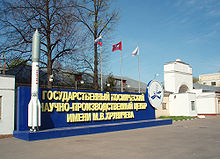Fili (Moscow)
Appearance


Fili (
Filyovsky park District (another related territory, Fili-Davydkovo District
, lies southwest of historical Fili).
History
The first mention of Fili is dated 1627. From 1689, Fili,
Peter I; its style is now known as Naryshkin Baroque. Naryshkin also established a new Fili village, closer to present-day Kutuzovsky Prospekt
; the old Fili was remodelled into his personal estate.
After the
General Kutuzov assembled in a wooden hut in Fili; despite objections from younger generals, Kutuzov insisted on his plan to abandon Moscow, saving the remains of the Russian army. They marched through Moscow on September 14, followed by Murat
's vanguard.
Fili was heavily industrialized between the 1900s and the 1930s, and by 1926 it had 396 households and 1,342 residents; in 1935, the territory was annexed by the City of Moscow. A notable feature of Fili is the
Junkers, producing local copies of Junkers K30 bomber, and vastly expanded afterwards. In 1926, this became Zavod 22, where the aircraft of Andrei Tupolev
were developed.
See also
- Church of the Intercession at Fili
- French invasion of Russia (1812)
References
- District administration, official site [1]
